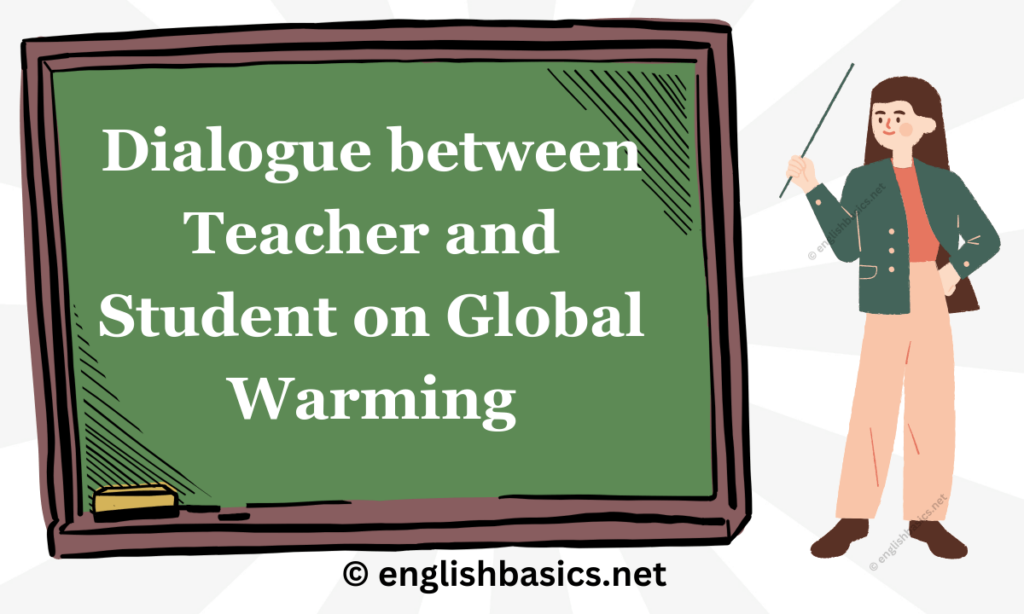This blog post looks at a dialogue between a teacher and a student on global warming.

Sample Dialogue between Teacher and Student on Global Warming – 1
Teacher: Good morning, students. Today we will be discussing a very important topic, global warming. Can anyone tell me what global warming is?
Student: Global warming is the gradual increase in the overall temperature of the Earth’s atmosphere.
Teacher: Very good! And what causes global warming?
Student: Global warming is mainly caused by the emission of greenhouse gases, such as carbon dioxide and methane, into the atmosphere.
Teacher: Correct. And what are some of the consequences of global warming?
Student: Some consequences of global warming include rising sea levels, more frequent and severe natural disasters, changes in weather patterns, and loss of biodiversity.
Teacher: Excellent, those are some of the most significant impacts. What can we do to reduce the effects of global warming?
Student: We can reduce the effects of global warming by reducing our carbon footprint, using renewable energy sources, and promoting sustainability. We can also support policies and initiatives aimed at reducing greenhouse gas emissions.
Teacher: Great, those are all essential steps we can take. We need to take action now to protect our planet for future generations. Thank you for your participation in today’s discussion.
Sample Dialogue between Teacher and Student on Global Warming – 2
Teacher: Good morning class, today we are going to talk about global warming. Can anyone tell me what global warming is in your own words?
Student: Global warming is when the Earth’s temperature is gradually getting hotter because of the increased levels of greenhouse gases in the atmosphere.
Teacher: That’s correct. Can you name some of the greenhouse gases that contribute to global warming?
Student: Carbon dioxide, methane, nitrous oxide and fluorinated gases are some of the main greenhouse gases that contribute to global warming.
Teacher: Good, those are the main ones. Can you explain how they contribute to global warming?
Student: These gases trap heat in the atmosphere, which leads to an increase in the Earth’s temperature. This, in turn, leads to changes in the climate, such as rising sea levels, more frequent and severe natural disasters, and shifts in weather patterns.
Teacher: Exactly, those are some of the most significant impacts of global warming. What can we do to reduce the effects of global warming?
Student: We can reduce our carbon footprint by using public transportation, recycling, reducing energy usage at home, and eating less meat. We can also support policies that promote clean energy and limit greenhouse gas emissions.
Teacher: Those are excellent suggestions. It is important for all of us to do our part in reducing the effects of global warming. Thank you for your participation in today’s discussion.
Sample Dialogue between Teacher and Student on Global Warming – 3
Teacher: Good morning, students. Today we are going to discuss global warming. Can anyone define global warming in their own words?
Student: Global warming is when the average temperature of the Earth’s atmosphere gets warmer because of increased levels of greenhouse gases.
Teacher: Excellent, that’s a great definition. Can you tell me some of the major sources of greenhouse gas emissions?
Student: Some of the major sources of greenhouse gas emissions include the burning of fossil fuels for energy, deforestation, and agriculture.
Teacher: Exactly, those are significant contributors to greenhouse gas emissions. Can you explain the impact of global warming on the environment?
Student: The impact of global warming can lead to rising sea levels, more frequent and severe natural disasters, changes in weather patterns, and loss of biodiversity. It can also have negative effects on human health and food security.
Teacher: Excellent, those are important impacts to consider. How can we reduce our carbon footprint and slow global warming?
Student: We can reduce our carbon footprint by using clean energy sources like wind and solar power. We can also reduce our energy usage by using energy-efficient appliances, using public transportation, and recycling. We can also support policies that promote clean energy and limit greenhouse gas emissions.
Teacher: Great, those are all excellent suggestions. Every small action we take can greatly impact reducing the effects of global warming. Thank you for your participation in today’s discussion.